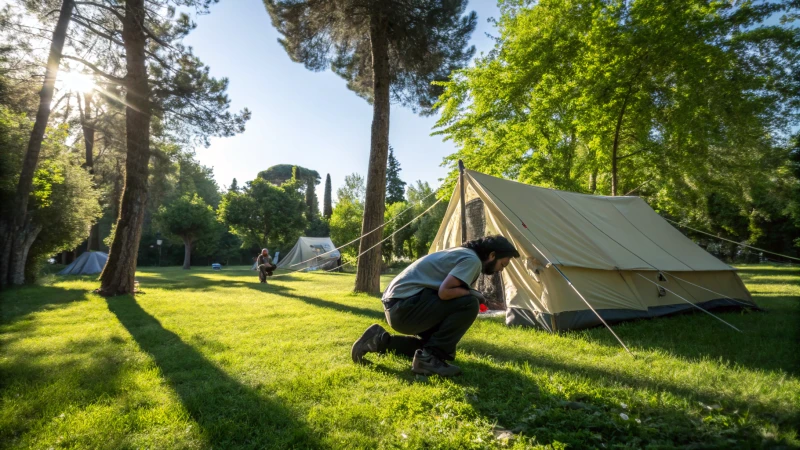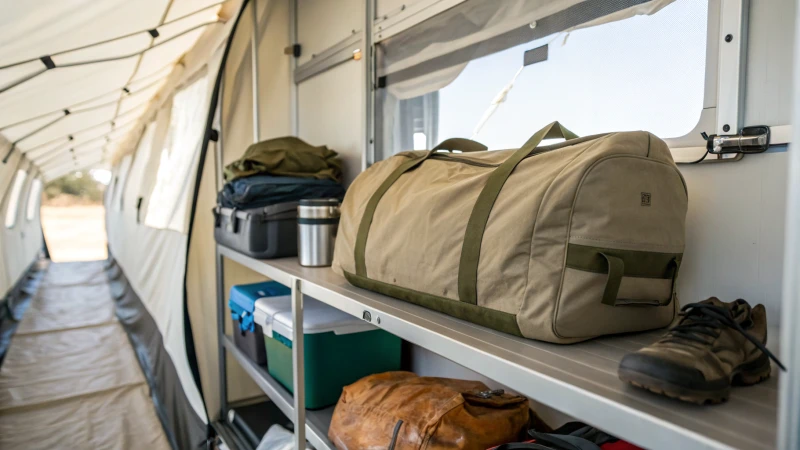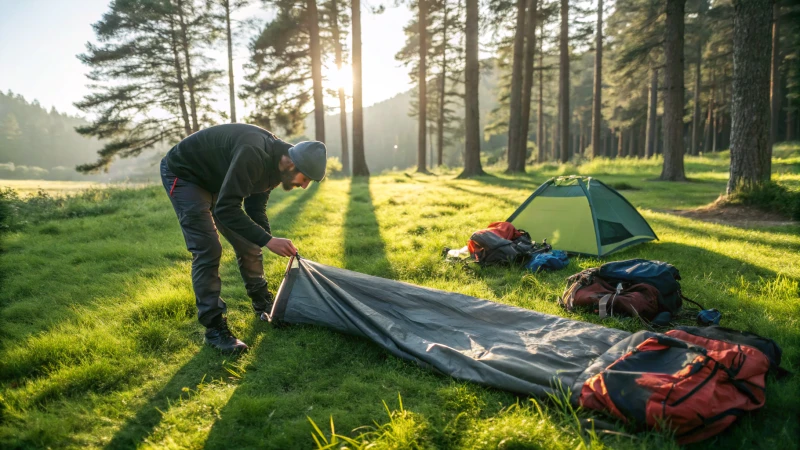
Have you ever found yourself wrestling with a stubborn tent that just won’t behave?
To keep your temporary outdoor tent in top shape, clean it with mild soap and water, check for damage, shield it from harsh weather, and store it properly. Always follow the manufacturer’s guidelines for best results.
I remember the first time I set up a tent in my backyard. It was a beautiful day, and I was excited to see it all come together. But as the days went by, I noticed that without proper care, my once pristine tent started to show signs of wear and tear. That’s when I realized the importance of regular maintenance. From carefully cleaning the fabric to inspecting every pole and stake, each step is crucial to ensure the longevity of your tent. After all, who wants to deal with a torn or rusted structure in the middle of an important event or family camping trip? With a bit of effort and attention to detail, your tent can remain a reliable shelter for all your adventures.
Regular cleaning with soap extends tent lifespan.True
Mild soap and water remove dirt, preventing material degradation.
Ignoring manufacturer guidelines enhances tent durability.False
Following guidelines ensures proper care, avoiding damage and extending life.
What Are the Best Cleaning Practices for Tent Fabric?
Ever wonder how to keep your tent looking and feeling as fresh as the day you bought it?
To effectively clean tent fabric, gently scrub with a soft brush or sponge using mild soap and water. Avoid harsh chemicals. Ensure thorough rinsing and air drying to prevent mold and mildew.

Why Regular Cleaning is Essential
I remember the first time I took my tent out after a long, adventurous trip. It had been through rain, mud, and a few unfortunate bird encounters. Regular cleaning keeps your tent fabric in prime condition, ensuring it stays durable and functional. After each use, I make it a habit to clean off dirt, mud, and debris with a soft brush or sponge. Using mild soap1 helps maintain the fabric’s integrity without damaging its waterproof features.
Choosing the Right Cleaning Products
I’ve learned the hard way that not all cleaning products are created equal. One time, I mistakenly used a harsh chemical cleaner, and it weakened my tent fabric significantly. Since then, I’ve opted for products specifically designed for tent fabric. Look for eco-friendly options2 that are gentle yet effective, and always follow the manufacturer’s guidelines on cleaning.
Techniques for Stain Removal
Stains are inevitable, especially when you love camping as much as I do. Treating them promptly can prevent permanent damage. For stubborn stains, I gently scrub with a mixture of mild soap and lukewarm water. Avoid using bleach, as it can discolor and degrade the material. For tough stains3, consider using a tent-specific cleaner.
Importance of Thorough Rinsing
After cleaning, it’s crucial to rinse off all soap residues thoroughly. I learned this lesson after discovering that leftover soap can attract dirt or lead to fabric deterioration over time. Use clean water and ensure no soapy bubbles remain before drying.
Effective Drying Methods
One mistake I used to make was not drying my tent completely before storage, which led to a moldy surprise next time I went camping. Always air dry your tent completely before storage. Moisture left in the fabric can lead to mold and mildew, compromising both appearance and structure. Choose a shaded area to avoid UV damage during drying.
Maintenance Tips for Longevity
I regularly inspect my tent for any signs of wear or damage. Addressing small rips or tears promptly with fabric patches or glue has saved me from bigger headaches later on. Reinforcing high-stress areas with additional support if necessary extends the tent’s life.
| Step | Action | Importance |
|---|---|---|
| 1 | Clean with a brush and mild soap | Removes dirt and protects waterproofing |
| 2 | Rinse thoroughly | Prevents residue build-up |
| 3 | Air dry completely | Avoids mold and mildew |
| 4 | Inspect for damage | Ensures readiness for next use |
Regular maintenance not only ensures the safety and comfort of users but also enhances the value of your investment in quality tent equipment. For additional information on specific product recommendations, consider exploring manufacturer resources4.
Using bleach on tent fabric can cause discoloration.True
Bleach can degrade the material, leading to color loss.
Air drying tents in direct sunlight is recommended.False
Direct sunlight can cause UV damage to the fabric.
How Can You Prevent Weather Damage to Your Tent?
One rainy night, as I huddled inside my tent listening to the wind howl, I realized just how important it is to safeguard your tent against the elements.
To prevent weather damage to your tent, make sure to set it up correctly with reinforced guy lines, apply UV-protection sprays, ensure good drainage, and use heavy-duty stakes. Regular checks and timely repairs are crucial.

Choose the Right Tent for the Weather
I remember one summer camping trip where I underestimated the sun’s power, and my tent was nearly bleached by the end. That’s why selecting a tent suited for your environment is key. Opt for materials designed to withstand the expected climate, like polyester for high UV resistance or canvas for durability.
Proper Setup and Location
I’ve learned that the perfect campsite makes all the difference. Choose a spot with natural protection, like a large rock or under a tree canopy, to minimize exposure to wind and rain. Make sure your tent is pitched tautly to avoid water pooling during a sudden downpour.
Securing Your Tent
There was this one time when I thought my tent might take off like a kite in strong winds. Using heavy-duty stakes5 and guy lines6 to anchor it firmly was a game changer. Tensioning the lines properly prevents flapping, which can cause wear over time.
Utilizing Protective Gear
On sunny days, I use UV-blocking sprays to protect my tent from sun damage. And when clouds roll in, a tarp7 provides an extra layer of protection against rain, reducing direct impact on the tent roof.
| Protection Gear | Purpose |
|---|---|
| Heavy-duty Stakes | Secure tent in high winds |
| Guy Lines | Maintain tension in windy areas |
| UV-blocking Spray | Prevent sun damage |
| Tarp | Extra rain protection |
Regular Maintenance and Inspection
I always inspect my tent after each trip for rips or weakened areas. Repairing minor damages promptly using patches or specialized fabric glue prevents bigger issues later.
Storage and Transport
Once, I made the mistake of packing my tent while it was still damp, leading to mold growth. Now, I make sure it’s clean and completely dry before storing it in a cool, dry place away from direct sunlight.
Be Proactive with Repairs
Keeping a repair kit handy is something I never skip. Fixing small damages as they occur has saved me from many headaches on future trips. Tent repair kits8 usually include everything you need for quick fixes.
Using these strategies helps keep my tent in top shape, ready to face any weather challenge on my outdoor adventures. Checking the forecast and preparing accordingly has become second nature, ensuring every camping experience is as smooth as possible.
Canvas tents are ideal for high UV resistance.False
Polyester, not canvas, is better for high UV resistance.
Heavy-duty stakes help secure tents in strong winds.True
Heavy-duty stakes provide stability and prevent tents from blowing away.
What Should You Check During a Tent Component Inspection?
Ever been caught in a storm with a leaky tent? Here’s how to ensure that never happens again by checking your tent’s components before every trip.
During a tent component inspection, check the fabric for tears, examine poles for bends or rust, ensure anchors are secure, and verify the functionality of zippers and seams. Regular inspections can prevent accidents and keep your tent in top condition for longer adventures.

Inspecting Tent Fabrics
I remember one camping trip when I discovered a small tear in my tent’s fabric just as it started to rain. The panic of scrambling to patch it up taught me the importance of regular inspections. Always start by checking the tent fabric for rips, holes, or frayed edges. If you find any small tears, repair them with patches or fabric glue to prevent further damage. Keeping the fabric taut and free from UV or water damage is key, and applying a UV protection spray9 can offer extra defense against sun exposure.
Checking Tent Poles
Tent poles are truly the backbone of your setup. I once found myself trying to sleep in a tent with a bent pole – not an experience I’d recommend! Inspect your poles for any bends, cracks, or signs of rust. If they’re bent, they might need straightening or replacement. To keep them rust-free and functioning smoothly, regularly apply lubricant to the metal joints. A handy tent pole maintenance guide10 can offer further insights.
| Pole Condition | Action Required |
|---|---|
| Slight Bend | Straighten |
| Major Bend | Replace |
| Rust Present | Clean & Lubricate |
Evaluating Anchors and Stakes
On another trip, I learned the hard way about securing stakes properly when the wind picked up. Ensure all your stakes, ropes, and weights are free of corrosion or wear. Replace any weak or damaged components because effective anchoring is essential for keeping your tent grounded during adverse weather conditions.
Examining Zippers and Seams
You might not think much about zippers until one gets stuck, leaving you wrestling with it in the middle of the night. Make sure zippers glide smoothly without snagging. Check seams for loose threads or gaps that could compromise water resistance, and consider using seam sealant for extra protection against moisture ingress.
Regular Maintenance Tips
To avoid any surprise hiccups, perform regular maintenance on your tent. Reinforcing high-stress areas like corners or pole junctions can provide added durability. For comprehensive maintenance strategies, explore this guide11.
Remember, a well-maintained tent not only keeps you safe but also enhances your camping experience by providing a secure and comfortable shelter. Keeping on top of these checks means fewer sleepless nights worrying about leaks or collapses and more nights enjoying the stars.
UV protection spray prevents fabric water damage.False
UV protection spray guards against sun damage, not water.
Rusty tent poles should be cleaned and lubricated.True
Cleaning and lubricating rusty poles helps prevent further corrosion.
Why Is Proper Storage Crucial for Tent Longevity?
Imagine heading out for a weekend camping trip only to find your tent unusable due to poor storage. That’s a nightmare! Let’s explore why proper tent storage is key to ensuring your adventures go smoothly.
Proper tent storage is crucial for its longevity because it prevents material degradation, mold growth, and pest damage. Always store your tent clean, dry, and in a cool, shaded place to maintain its integrity.

The Impact of Environmental Factors
I’ve learned the hard way that where you store your tent can make all the difference. I once stashed mine in a damp garage corner, and when I pulled it out for a weekend getaway, it was covered in mold. Moisture and humidity12 are silent killers, fostering mold and mildew that weaken your tent’s fabric. Direct sunlight isn’t any kinder, as it can cause UV damage and make the material brittle. Now, I always opt for a cool, dry storage spot.
Cleaning Before Storage
Let me tell you about the time I regretted skipping a post-camping cleanup. That oversight led to pests turning my tent into their playground. I now make it a point to clean and dry my tent thoroughly before storage. A gentle scrub with mild soap and a soft brush does wonders. Air drying ensures there’s no moisture left to invite mold.
A clean tent13 not only remains fresh but also ensures longevity.
Using the Right Storage Bag
A lesson from experience: Avoid cramming your tent back into its tiny sack for long-term storage. It’s like trying to fit into those jeans from high school—unnecessary stress on the seams! Instead, I invest in a spacious, durable storage bag14 to protect against dust and pests.
| Storage Tips | Benefits |
|---|---|
| Clean thoroughly | Prevents mold and extends fabric life |
| Store in a cool, dry place | Avoids UV and moisture damage |
| Use a spacious storage bag | Reduces stress on materials |
Regular Inspections and Maintenance
I can’t emphasize enough how vital regular check-ups are. Even when tucked away safely, I periodically inspect my tent for any signs of damage like holes or weakened seams. Quick repairs can prevent bigger headaches down the line. Also, applying UV protection sprays and lubricating metal parts helps keep everything in top shape.
Applying UV protection sprays and lubricating metal parts can also be beneficial for maintaining tent integrity15.
By focusing on these aspects, I’ve been able to protect my investment and ensure my tent is always adventure-ready. Proper storage not only boosts its longevity but keeps it in great condition for all those memorable trips.
Direct sunlight can cause UV damage to tents.True
UV rays break down tent fabric, making it brittle and weak.
Compression sacks are ideal for long-term tent storage.False
They strain the fabric and seams, risking damage over time.
Conclusion
Maintain your temporary outdoor tent by cleaning it regularly, inspecting for damage, protecting against weather, and storing it properly to ensure longevity and functionality for future use.
-
Discovering recommended mild soaps helps protect your tent’s material from harsh chemicals. ↩
-
Eco-friendly options ensure safe cleaning practices while preserving the environment. ↩
-
Learning effective stain removal techniques prevents lasting damage to your tent. ↩
-
Manufacturer guidelines offer tailored advice for maintaining your specific tent model. ↩
-
Discover top-rated heavy-duty stakes that ensure your tent stays secure even in high winds. ↩
-
Learn effective techniques for using guy lines to maintain your tent’s stability in adverse conditions. ↩
-
Explore how adding a tarp over your tent can enhance its protection against rain and sun. ↩
-
Find out what tools and materials are essential for quick and efficient tent repairs. ↩
-
Discover top-rated UV protection sprays to safeguard your tent fabric from sun damage. ↩
-
Learn techniques to keep your tent poles in top condition, ensuring durability and reliability. ↩
-
Access a detailed guide on maintaining every part of your tent to ensure longevity and performance. ↩
-
Understanding how moisture impacts tent materials helps prevent mold and fabric deterioration. ↩
-
Learn effective cleaning techniques to maintain tent hygiene and material quality. ↩
-
Discover storage solutions that protect tents from environmental damage and pests. ↩
-
Explore maintenance practices that preserve tent functionality during off-seasons. ↩







